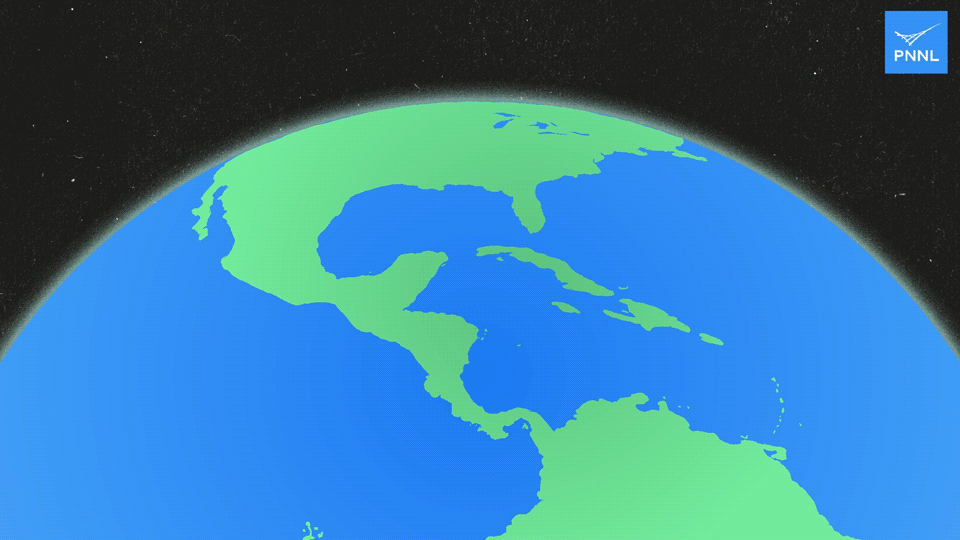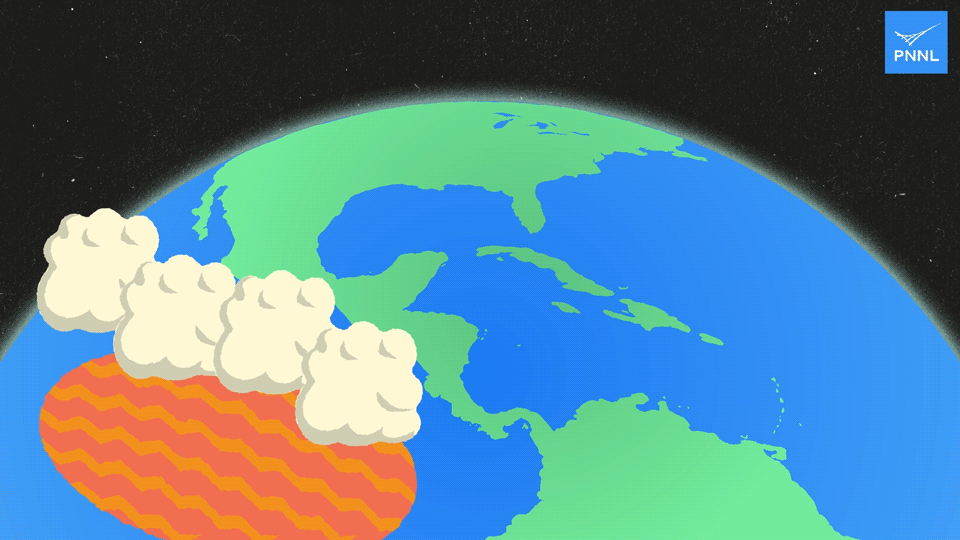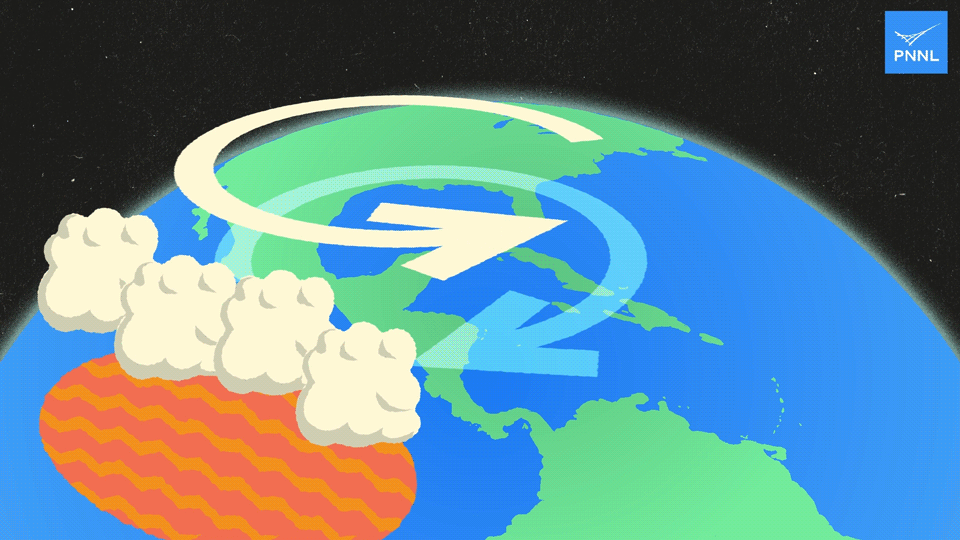Global warming increases the frequency of hurricanes
Warming tropical waters can lead to changes in winds that strengthen and drive hurricanes, increasing frequency by a third compared to current levels.
Pacific Northwest National Laboratory*
You Hurricanes will get stronger It will strike most frequently the US Gulf and Lower East Coast, according to new research led by scientists at the Department of Energy’s Pacific Northwest National Laboratory, which explored The effect of global warming on storms Harmful . They warn that if current warming trends continue, the frequency of hurricanes could increase by a third compared to current levels.
on Article published in Science Advances researchers describe a previously unknown mechanism that increases risk to coastal populations.
Changes in winds from Earth’s upper atmosphere – caused by a warming of the sea surface in the eastern Pacific Ocean – are responsible for the expected increase in the frequency of hurricanes in coastal regions.
“What we found is that these changes in winds have a dual effect,” said lead author and climatologist Karthik Balaguru. First, they drive storms near the US Gulf and East Coasts, posing risks to the people who live there. But these same changes in winds also reduce vertical wind shear near the coast, which will eventually lead to enhanced coastal storms. When these two factors work together, it makes the whole problem worse.”
Much work has been done to determine what changes make storms more harmful in a warming world. For example, previous studies predicted that vertical wind shear—the force that typically weakens a hurricane by weakening its strength—will weaken under global warming. Balaguru said that wind shear weakens, and storms strengthen.
Other research has predicted that tornadoes may move more slowly, giving storms more time to cause damage. But so far, these changes have largely been attributed to the general effect of global warming, with no specific mechanism.
“Global warming can mean many different things,” Balaguru said. “We wanted to know exactly who is responsible for these changes in a warmer world. Finding out the reason behind these changes, as we have done here, is satisfying from a scientific perspective, but also important as we deepen our understanding of what influences extreme weather.”
More hurricanes, more dangers
To understand what the risks posed by hurricanes in the future might look like, Balagoro needed one thing: more storms. Only a handful of hurricanes make landfall in the United States each year—too few for a solid analysis.
Tornadoes are often simulated by researchers Models representing Earth’s climate . But these simulations can get computationally expensive quickly. The models will need high enough accuracy, and to generate the numbers needed to make reliable forecasts, researchers will have to run a lot of storm simulations.
Balaguru and colleagues developed a unique model known as raft . The advantage of RAFT is that it can detect many of the factors that make up hurricanes, from the winds that drive storms to the warm waters from which they derive energy. It is meant to be integrated with climate models, and can also generate many simulated storms, which allows for powerful statistical analyses.
This skill allowed Balaguru’s team to examine the relative importance of each contributing factor behind the changes. Balaguru said the resulting study marks the first time such an analysis has been done.
“We’ve seen that the frequency of storms near the coast has changed,” Balaguru said. “But why? Is it because the storms are getting stronger? Is it because they are going more in that direction? Our approach helped us isolate the key variables at play and identify the ones that matter most.”
RAFT has produced hundreds of hurricane vectors: the tracks that hurricanes follow after they form over ocean waters. The results showed that if current global warming trends continue, storms will intensify and hit the eastern and Gulf coasts more frequently.
By increasing the frequency of hurricanes, Balaguru’s team found that one factor was more dominant than all the others: wind.
What makes hurricanes worse?
The authors of the new study uncover a previously undescribed mechanism behind Increased frequency of coastal cyclones. It begins with a relatively stronger rise in the eastern Pacific Ocean, where the sea surface is usually cooler.
like Greenhouse gas emissions continue to rise , they trap more and more heat in the Earth system. This causes the land and sea surface to warm, though not uniformly. Most climate models project a higher sea surface temperature in the eastern Pacific than in the central Pacific.
As the sea surface temperature rises, more water evaporates from the ocean’s surface and humidifies the air above it. Because moist air is less dense, it rises higher in the atmosphere, where moisture condenses to form clouds and release heat. This process is known as convection.
This convection generates a planetary pattern of waves in the atmosphere known as a planetary wave Rossby waves . Although this process begins in the eastern Pacific Ocean, the effect of Rossby waves spreads over great distances. In this case, the rotation created by these waves changes so that the air moves clockwise near the surface over the Gulf of Mexico. But higher in the atmosphere, the air moves in the opposite direction.
In other words, this Rossby waves produce circulation patterns in the atmosphere like cyclones and anticyclones – PNNL scientists have explored these patterns and their effects before .
These waves eventually cause changes in winds in the upper and lower troposphere—the winds that drive hurricanes. Take a look at the third animation below. Note the counterclockwise movement of air caused by a Rossby wave in the upper atmosphere. This movement is what pulls and pushes hurricanes towards the eastern and Gulf coasts. These changes in wind direction that determine a hurricane’s path have the additional effect of weakening wind shear, making ground-based storms stronger.
Previous research on the driving winds that drive tornadoes has made similar predictions. But this work marks the first time that scientists have proposed a physical mechanism behind changes that make coastal storms more harmful in a warmer future.
“Many studies have shed light on how hurricanes may change in the future,” said atmospheric scientist and study author Robbie Leung. “By identifying a mechanism that links the various changes of hurricanes, this study provides a more unified perspective, highlighting the risks of future coastal cyclones.”
Some uncertainties remain, according to the study authors. A better understanding of ring formation — the process by which tornadoes form — could help paint a more detailed and accurate picture of tornado behavior. It could also lead to further study and better modeling of sea surface warming More robust and detailed forecasts .
in your Our effort to better understand the processes that govern hurricane changes the team plans to explore how global warming affects tropical cyclones in other coastal regions.
In addition to Balaguru and Leung, PNNL writers include Wenwei Xu, Chuan-Chieh Chang, David Judi, and Samson Hagos. Michael Weiner of Lawrence Berkeley National Laboratory, James Kosin of the Climate Service, and Mingfang Ting of Columbia University are also authors. This work was funded by the Department of Energy’s Office of Science.
reference:
Balaguru K, Xu W, Chang CC, Leung LR, Judi DR, Hagos SM, Wehner MF, Kossin JP, Ting M. Increased risk of US coastal cyclones under climate change. Science lecturer. 2023 Apr 7; 9 (14): eadf0259. This painful: 10.1126/sciadv.adf0259. Epub 2023 Apr 7, PMID: 37027466; PMCID: PMC10081849.
Henry Cortez * Translation and editing.
[ Se você gostou desse artigo, deixe um comentário. Além disso, compartilhe esse post em suas redes sociais, assim você ajuda a socializar a informação socioambiental ]
In EcoDebate, ISSN 2446-9394
EcoDebate e-journal can be maintained thanks to technical support and hosting porto vasil.
[CC BY-NC-SA 3.0][ O conteúdo da EcoDebate pode ser copiado, reproduzido e/ou distribuído, desde que seja dado crédito ao autor, à EcoDebate com link e, se for o caso, à fonte primária da informação ]

“Coffee trailblazer. Social media ninja. Unapologetic web guru. Friendly music fan. Alcohol fanatic.”



